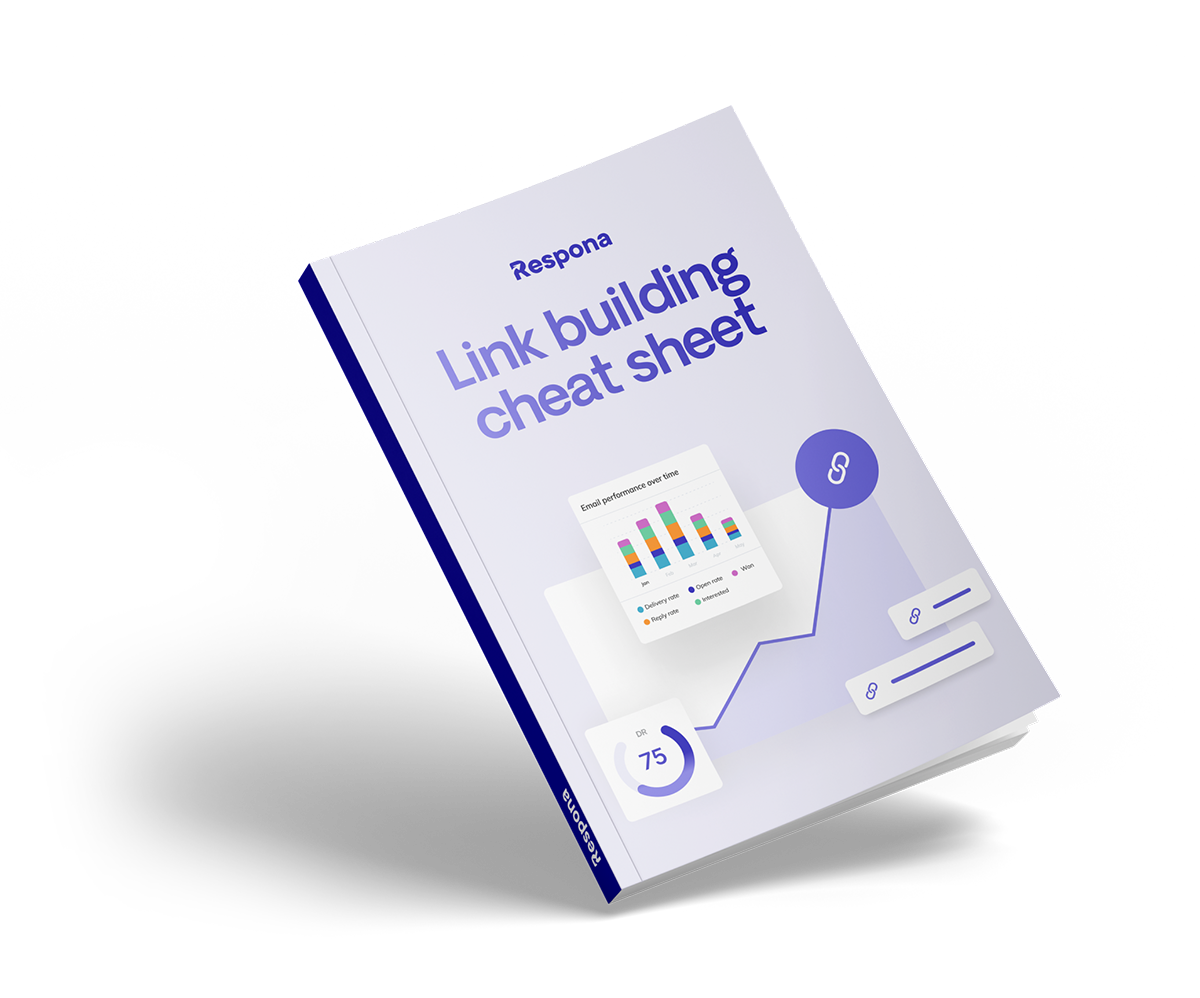Link building and SEO is super confusing.
Especially since Google seems to change their algorithm every few months.
So, an awesome guide that was relevant only a year ago might already be outdated.
To save you the pain of looking up the answers to each individual question, we’ve compiled a list of the top 65 questions about link building, off-page seo, blogger outreach, and email deliverability in general.
All answered by yours truly, our team.
Updated for 2024.
Link building cheat sheet
15 Link Building Questions
Before we dive into the questions themselves, we highly encourage you to check out our link building video course.
It answers most of these questions in a much more digestible format.
1. What is link building, and why is it important for SEO?
Link building is the process of getting inbound links to your website from other relevant sources.
It’s important for SEO because backlinks deeply ingrained in Google’s algorithm and play a major role in your site’s SERP rankings.
More links = better rankings(as long as it’s done correctly).
2. How do you identify high-quality backlinks?
A high-quality backlink has all (or at least some) of the following qualities:
- Topical relevance
- Placement on an authoritative website that drives real traffic
- Has no or few other links on the same page
You can use backlink monitoring tools like Ahrefs to check websites’ traffic and authority.
3. What are some effective link building strategies for 2024?
The best way to build links in 2024 is by writing guest posts and including your partners’ links in them in exchange for a link to your website.
Other strategies like broken link building can be a little more niche, and work for some sites but not others.
4. How do you check the quality of a website before building a link to it?
- Look at the site – if it has poor quality content, clearly templated layout, and dozens of external links per page, it’s a link farm that you should avoid.
- Look at the website’s traffic and authority/domain rating in the SEO monitoring tool of your choice (Ahrefs, Moz, Semrush, etc.)
5. What are the risks of poor-quality link building?
Nowadays, Google isn’t as trigger-happy with its penalties.
Low-quality links are recognized and de-valued by the algorithm, so your biggest risk is wasting your time.
However, once you dip into black-hat tactics such as negative SEO attacks or selling links that are not marked as sponsored, you do risk getting spotted by Google and have your site removed from search results entirely.
6. How do you use anchor texts effectively?
The only “golden” rule for an anchor text (the words the actual link is placed on), is that the reader must not be mislad.
Meaning, your anchor text and link should match up – and the user must land on the page they expect to land on.
So, for example, it makes sense to link to our link insertion (that we also call the anchor text strategy) tutorial here.
But, linking to, for example, a general guide on SEO wouldn’t make nearly as much sense and the link would be misleading.
7. What role does internal linking play in a link building strategy?
Just like external links, internal ones pass on link equity, or “link juice”.
Besides the navigational and user retention benefits, a solid internal linking structure also helps bump up new content with equity from already ranking pages.
Internal links also influence crawlability by search engines, so you should always make sure all your pages are accessible in 3 clicks or less.
8. How can you recover from Google penalties related to link building?
To recover from Google penalties related to link building, start by identifying and removing or disavowing low-quality and spammy backlinks that violate Google’s guidelines.
After cleaning up your backlink profile, submit a reconsideration request to Google, explaining the steps you’ve taken to rectify the issue and prevent future infractions.
9. What are the best tools for managing a link building campaign?
Respona is the best all-in-one email outreach and link building tool.
It streamlines and automates the entire link building process – from prospecting to finding contact information, personalization, and handling replies.
10. How do you measure the success of a link building campaign?
The average reply rate for link building emails is around 10%.
You can expect half of those replies to be negative.
And out of the positive replies, you can expect for half to not pull through with the collaboration.
So, if you’re getting 2-3 links out of 100 emails, you can consider it effective.
However, you can definitely get more results out of your outreach through in-depth personalization and attractive value propositions.
11. What are the differences between white hat, black hat, and grey hat link building?
White hat (or white label) link building follows ethical guidelines and search engine rules, focusing on quality content and natural backlinks.
Black hat link building uses manipulative tactics like spamming or buying links to boost search engine ranking quickly, risking penalties.
Grey hat link building falls in between, employing tactics that aren’t explicitly against rules but may still be risky.
12. How does content marketing tie into link building?
Content on its own rarely generates any traffic. Link building is aimed to amplify your content and actually get it to rank and get clicks.
13. What are the latest Google algorithm updates that affect link building?
As of July 2024, the latest Google algorithm updates that affect link building include the “Link Spam Update 3.0,” which further cracks down on unnatural link practices by using advanced AI to identify and devalue spammy links.
Additionally, the “Content Relevance Update” emphasizes the quality and contextual relevance of backlinks, making it crucial for sites to obtain links from reputable and contextually similar sources.
14. How do you scale a link building campaign?
By automating the most time-consuming processes, such as prospecting, personalization, and, of course, finding contact information.
15. How can small businesses with limited budgets implement effective link building strategies?
By using automation tools and delegating to a dedicated link builder.
Even if it’s only a part-time task, having an in-house link building specialist to manage the process (with the right tools) is the best way.
You may also choose to outsource to a fully-managed SEO link building service, but those are typically more expensive than a DIY approach.
Alternatively, there are thousands of freelance link builders – but you have to thoroughly vet them to ensure you’re hiring an actual link building expert.
15 Off-Page SEO Questions
1. What is off-page SEO, and how does it differ from on-page SEO?
Besides link building, off-page SEO involves optimizing external factors that influence search engine rankings, such as, social media signals, and online reputation management (like your GMB profile and other directory listings).
On-page SEO, on the other hand, focuses on optimizing elements within your own website, such as content quality, keyword usage, meta tags, and site structure.
2. How important are social signals in off-page SEO?
Likes, shares, and comments on social media platforms, play a significant role in off-page SEO by indicating content relevance and popularity to search engines.
While they may not directly affect rankings as strongly as backlinks, they help drive traffic, increase visibility, and enhance online authority, indirectly contributing to improved search engine performance.
3. How do brand mentions impact off-page SEO?
Brand mentions impact off-page SEO by enhancing a website’s credibility and authority even without direct backlinks.
4. What role does influencer marketing play in off-page SEO?
Influencer marketing is less about SEO and more about sales.
Links from influencers must always be marked as “sponsored” or “ugc”, which acts a lot like “nofollow”, meaning these links don’t have SEO value.
Still great for tapping into targeted audiences though.
While the mentions, links, and videos are great for visibility, they affect your SEO much less.
5. How can businesses benefit from guest blogging?
Not only are guest posts a great way to get some links to your site from author’s bio sections, but are a great way to set up safe, indirect link exchanges (aka ABC exchanges).
You can write guest posts, send drafts to your link building partners, and include their links in them instead of doing reciprocal exchanges – which are restricted by Google.
6. What are some common mistakes to avoid in off-page SEO?
Focusing solely on quantity over quality in link-building by acquiring numerous low-quality or spammy backlinks – as well as buying links.
Another mistake is neglecting social signals and reviews on GMB and platforms like G2 and Capterra.
7. How do online reviews affect off-page SEO?
Online reviews’ primary purpose is to increase trust with potential customers and help with lead generation.
Links from review platforms like G2 are typically marked as “UGC”, so their impact on rankings are minimal.
8. What is the role of forum participation in off-page SEO?
Forum links are not an effective link building method – and are not counted by the algorithm.
Instead, you should participate in forums to build rapport with users (both potential and existing) – and help them out with whatever questions they may have.
9. How can you effectively use social media for off-page SEO?
Share high-quality content consistently and engage with your audience through comments, likes, and shares to build a community around your brand.
Additionally, use socials to promote your content, encouraging backlinks and traffic from users who find your posts valuable and relevant.
10. What are some off-page SEO strategies that work well for local businesses?
For local businesses, perhaps the most important off-page strategy is to create and optimize your Google My Business profile, ensuring accurate and complete information for..
Another local SEO strategy is to gain citations and listings in local directories, as well as encouraging satisfied customers to leave positive reviews on platforms like Yelp and local forums.
11. How does video marketing contribute to off-page SEO?
Video marketing contributes to off-page SEO by increasing engagement, shares, and backlinks as users find and share valuable video content across platforms.
Additionally, videos hosted on sites like YouTube, which is owned by Google, can improve your online visibility and drive traffic back to your website.
12. What is the significance of directory submissions in modern-day SEO?
Business directories also have less SEO impact than backlinks from other industry-relevant sites that are run by other businesses.
However, these directories cannot be overlooked because they typically allow users to leave reviews – which is one of the strongest driving tools for your discoverability.
13. How can businesses leverage Q&A sites for off-page SEO?
Sites like Quora and Reddit aren’t very good for SEO because user-generated links aren’t as valuable as dofollow links.
However, they still make for great opportunities to engage with your audience on “neutral territory” (aka media not owned by you) – and gently nudge them towards checking out your business.
14. How do press releases contribute to off-page SEO?
Press releases generate high-quality backlinks from reputable news outlets and distribution services.
They also increase brand visibility and can drive traffic through media coverage, improving overall search engine rankings through digital PR.
15. How can you monitor and improve your off-page SEO efforts?
Use tools like Google Analytics and Ahrefs to track inbound links, referral traffic, and social signals.
Regularly analyze the quality and relevance of your backlinks, adjust your outreach strategies, and focus on building relationships with authoritative sites in your industry to continuously enhance your off-page SEO.
15 Blogger Outreach Questions
1. What is email blogger outreach, and why is it important for link building?
As you already guessed, it’s the process of finding and reaching out to bloggers through email.
It’s important for SEO because it’s one of the best ways to connect with website owners for link collaborations.
2. How do you find relevant bloggers to reach out to?
You can start by doing a Google search – and look up the site owners on LinkedIn.
But, the manual approach is time-consuming, so to do outreach at scale, you’ll need the help of blogger outreach tools like Respona.
3. What are the best practices for email blogger outreach?
Our top 3 best practices are:
- Personalize your emails and have a solid value proposition
- Easy on the follow-ups (1-2 is enough, with 3-5 days in between)
- Warm up your emails, and keep an eye on your email account’s health
4. How can you personalize your outreach emails to improve response rates?
Good personalization shows that you’ve spent some real time researching your prospect.
It doesn’t have to be huge, but something like “congrats on hitting 100k traffic a few months back!” can go a long way.
Just don’t dig into personal stuff – that’s a bit much.
5. What common mistakes should you avoid in blogger outreach emails?
Not checking for spam words, sending messages that are way too long, being unclear as to how your recipient will benefit from collaborating.
Also following up every day.
Seriously, please stop. You know who you are.
6. How do you craft an effective subject line for outreach emails?
It must be short, personalized, and to the point.
The recipient must immediately understand what your email is going to be about before they even open it.
Tip: start your subject lines with a lowercase letter. It looks like a typo, makes your pitch look more human, and visually stand out from the rest (99% of which have every word capitalized).
7. How many follow-ups should you send if you don’t get a response?
Two at most.
We only do one, but two is okay – as long as they’re spaced out by 3-5 business days.
If the recipient hasn’t answered after your initial email and 2 follow-ups. Chances are they saw your messages, and are just not interested.
8. What tools can help with email blogger outreach?
Respona is tailor-made for automating blogger outreach – and offers a variety of campaign templates for different outreach goals, including link building, PR, podcast outreach, and content promotion.
9. How do you handle negative responses or rejections in outreach?
Just leave them alone. If they’re not interested, there’s no point in arguing.
If a potential partner is very important to you, you can try negotiating by adding an extra value proposition, but if they’re still not interested, you should definitely let them go – or risk getting reported as spam.
10. What metrics should you track to measure the success of your outreach campaigns?
Response rate, conversion rate, and the number of backlinks acquired.
Additionally, monitor referral traffic, domain authority improvements, and social shares generated from your outreach.
11. How can you build long-term relationships with bloggers?
Set up recurring link collaborations, pitch guest posts, and think of other ways to collaborate – such as co-host a webinar, write a joint ebook, etc.
12. How do you pitch guest posts effectively?
The most effective way to pitch a guest post is by first doing keyword research for your target, letting them know you found some missing keywords (with a screenshot) and offer to write a guest post to cover the content gap.
This even works on some sites without a “Write for Us?” page.
13. What should you include in an outreach email to make it compelling?
The value proposition is the most important – aka what your recipient will gain by working with you.
Since they most likely don’t know you, they only care about how they’ll benefit.
This may sound a bit rude, but nobody wants to work for free.
14. How do you ensure that your outreach emails comply with anti-spam laws?
Include an easy and clear opt-out or unsubscribe option.
Additionally, provide accurate sender information and a clear subject line that reflects the content of the email to maintain transparency.
Double opt-in is also required in some places, but it’s impossible for cold outreach – so this applies more to email newsletters.
15. How important is timing when sending outreach emails?
Timing can significantly impact the open and response rates.
Send emails during typical business hours and avoid weekends or holidays to increase the likelihood of your email being noticed and responded to promptly.
Depending on who you’re contacting (and what for), the exact time that’s best for you to send will be different.
20 Email Deliverability Questions
1. What factors influence email deliverability?
Sender’s reputation, which is determined by past email behaviors and user interactions, is the main one.
Other key factors include the accuracy of the recipient’s email address, the content quality of the email, avoiding spammy language, and ensuring proper authentication protocols like SPF, DKIM, and DMARC are in place.
2. How do you improve your email deliverability rates?
Use a reputable email service provider, authenticate your emails with SPF, DKIM, and DMARC protocols, and create high-quality, and regularly clean your email list, if you keep one.
3. What is a good email deliverability rate?
2-3% bounce rate is considered “great”.
Anything below 5% is okay, but once you notice a dip below that, measures must be taken.
4. How do spam filters work, and how can you avoid them?
Spam filters check for suspicious keywords, excessive links, and poor formatting, as well as the sender reputation and authentication credentials.
To avoid them, use clear, relevant subject lines, maintain a balanced text-to-image ratio, avoid spammy language, and ensure your email list is up to date with engaged recipients.
5. What role does sender reputation play in email deliverability?
Sender reputation reflects the trustworthiness and reliability of your email domain and IP address based on past sending behaviors.
A good sender reputation, built by consistent engagement rates, low bounce rates, and minimal spam complaints, increases the likelihood of your emails reaching recipients’ inboxes instead of their spam folders.
6. How do you maintain a clean email list?
Regularly remove invalid, bounced, or inactive email addresses and segment your list to ensure targeted, relevant content for different audience groups.
Use high-quality email finders like Respona to find accurate email information in real-time.
Additionally, use double opt-in methods to confirm subscriptions and periodically ask subscribers to update their preferences and confirm their interest.
7. What are the best practices for email authentication (SPF, DKIM, DMARC)?
Follow our tutorial to set up SPF, DKIM, and DMARC.
8. How does the quality of your email content affect deliverability?
Massively.
Bad and spammy content will trigger spam filters, leading to your messaging ending up in spam folders instead of your recipients’ inboxes.
9. How can you test your email deliverability before launching a campaign?
Respona runs daily email health checks of your DNS records, Spam Assassin score, and your account’s presence on common blacklist.
10. What is email warming, and why is it important?
Email warming is the process of starting at a low daily email limit (~10/day), and slowly increasing it to around 40 over the course of a month.
This eases new email accounts into outreach and helps improve sender reputation before diving into large campaigns with full force.
Skipping this step for a new sender email that has little to no sender reputation will result in your messages ending up in spam.
There are also automated warmup tools like lemwarm, but Google is against those as they circumvent its spam algorithm.
11. How do you handle hard bounces and soft bounces?
“Soft” bounces you don’t need to do anything about. They happen because a user hasn’t given permission to receive external emails, or their mailbox is full.
“Hard” bounces, on the other hand, are bad for deliverability.
To avoid them, use quality email finders like Respona, avoid generic email addresses like “hello@domain”, as well as catch-all emails.
12. What are blacklistings, and how can you avoid them?
Blacklistings occur when email servers identify and block your domain or IP address due to suspected spam activity, preventing your emails from reaching recipients’ inboxes.
To avoid blacklistings, maintain a positive sender reputation by sending emails to engaged and opted-in users, avoiding spammy content, and monitoring your email metrics to promptly address any issues that could harm your reputation.
13. How does engagement (open rates, click-through rates) affect email deliverability?
Email providers use these indicators to gauge whether recipients find your emails valuable.
High engagement rates suggest a positive user experience and can enhance your sender reputation, increasing the likelihood that future emails will be delivered to the inbox rather than the spam folder.
14. What are the common causes of low email deliverability?
The use of spammy language, sending too many emails a day (over 40 per email account), and not verifying your recipients’ email addresses before reaching out.
Also too many follow-ups.
15. How do you properly segment your email list for better deliverability?
Divide your subscribers based on criteria such as demographics, past purchase behavior, and engagement levels.
By tailoring content to specific segments, you can increase relevance and engagement, which helps maintain a good sender reputation and improves overall deliverability.
16. What metrics should you monitor to ensure good email deliverability?
Bounce rates, spam complaints, open rates, and click-through rates.
Additionally, track your sender reputation and the performance of your email authentication protocols (SPF, DKIM, DMARC) to identify and address any potential issues promptly.
17. How can you recover from poor email deliverability?
Stop all outreach and restart your email warmup process for a month or so.
Use a deliverability testing tool to gauge whether it’s ready to be used for proper outreach again or not.
18. How important is the role of email service providers (ESPs) in deliverability?
ESPs offe tools and infrastructure to manage large-scale email campaigns, ensure compliance with email authentication protocols, and maintain a good IP reputation.
They also provide analytics and insights to help monitor and improve engagement metrics.
19. How do you keep your emails out of the promotions tab in Gmail?
Focus on creating personalized, plain-text emails with minimal HTML and avoid using promotional language or excessive images.
Encourage recipients to move your emails to their Primary tab and add your email address to their contacts to improve the chances of your emails landing in the Primary inbox.
20. What strategies can you use to re-engage inactive subscribers?
Ssend targeted re-engagement campaigns offering special incentives, like discounts or exclusive content, to pique their interest.
Additionally, seek feedback through surveys to understand their preferences better and adjust your content strategy accordingly to rekindle their interest.
Link building cheat sheet
Now Over To You
Hope that answers all of your questions!
Looking to start to build links, or any kind of cold outreach for that matter?
Don’t hesitate to start your 14-day free trial with Respona to see how we can help first-hand.







